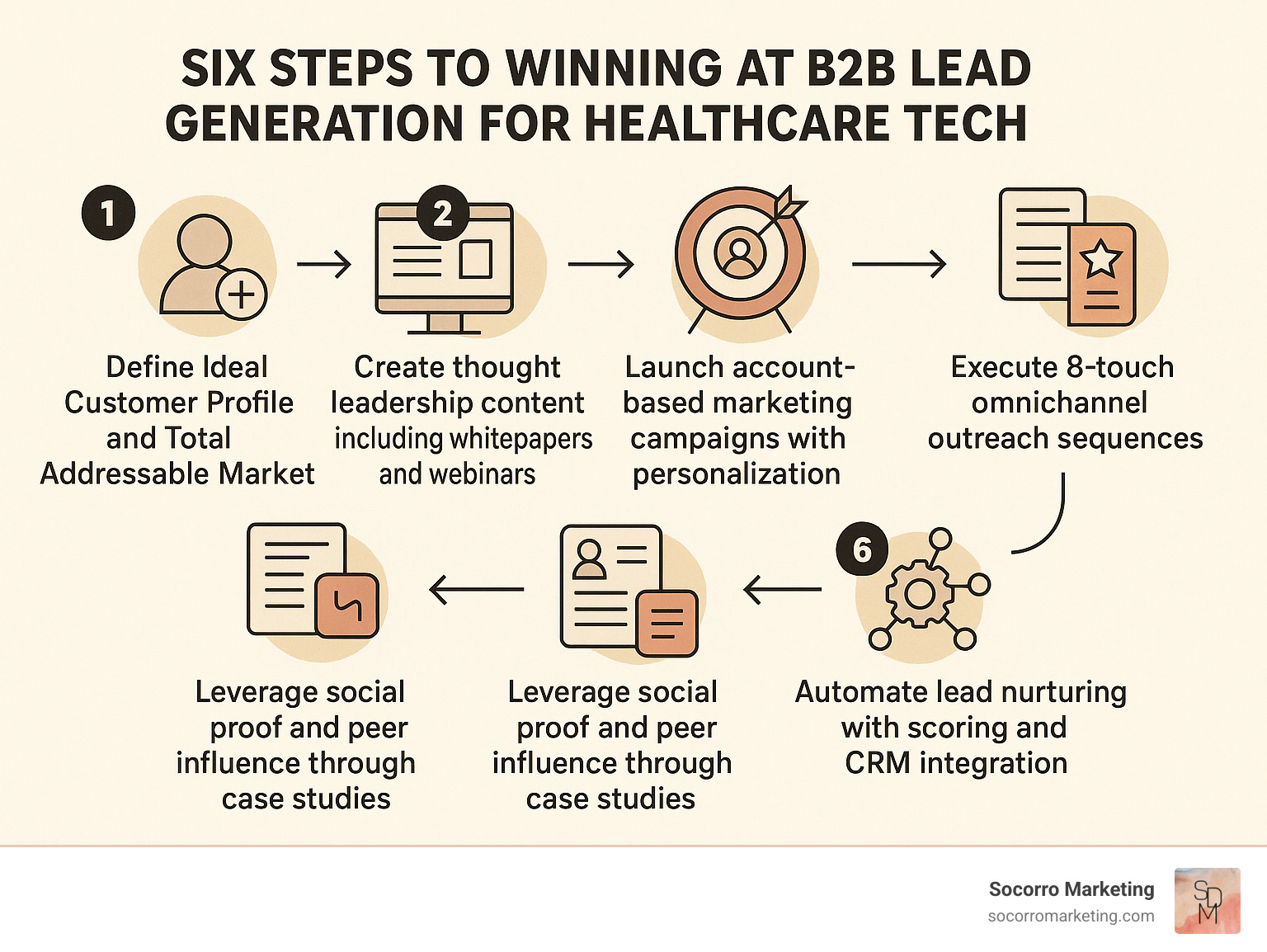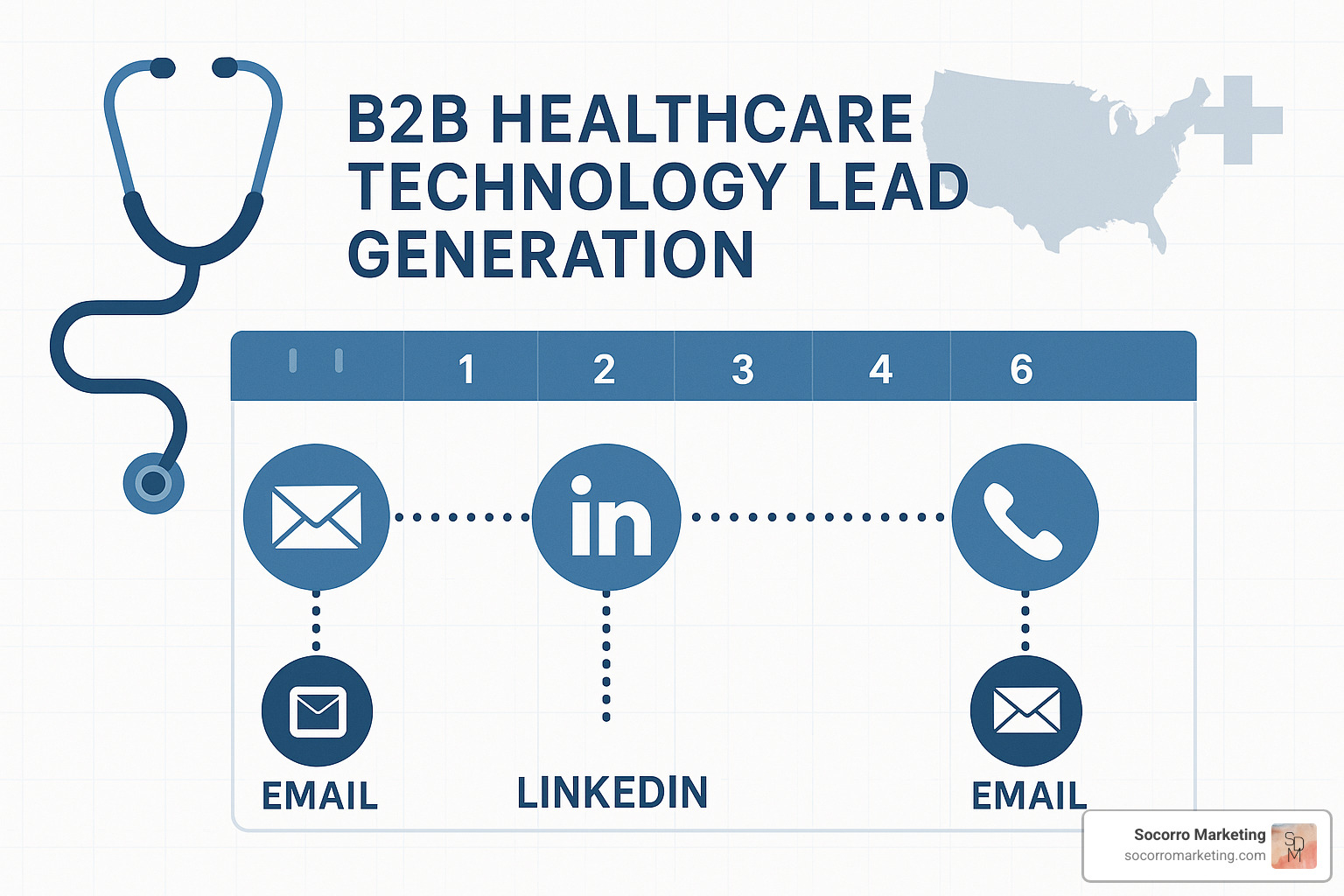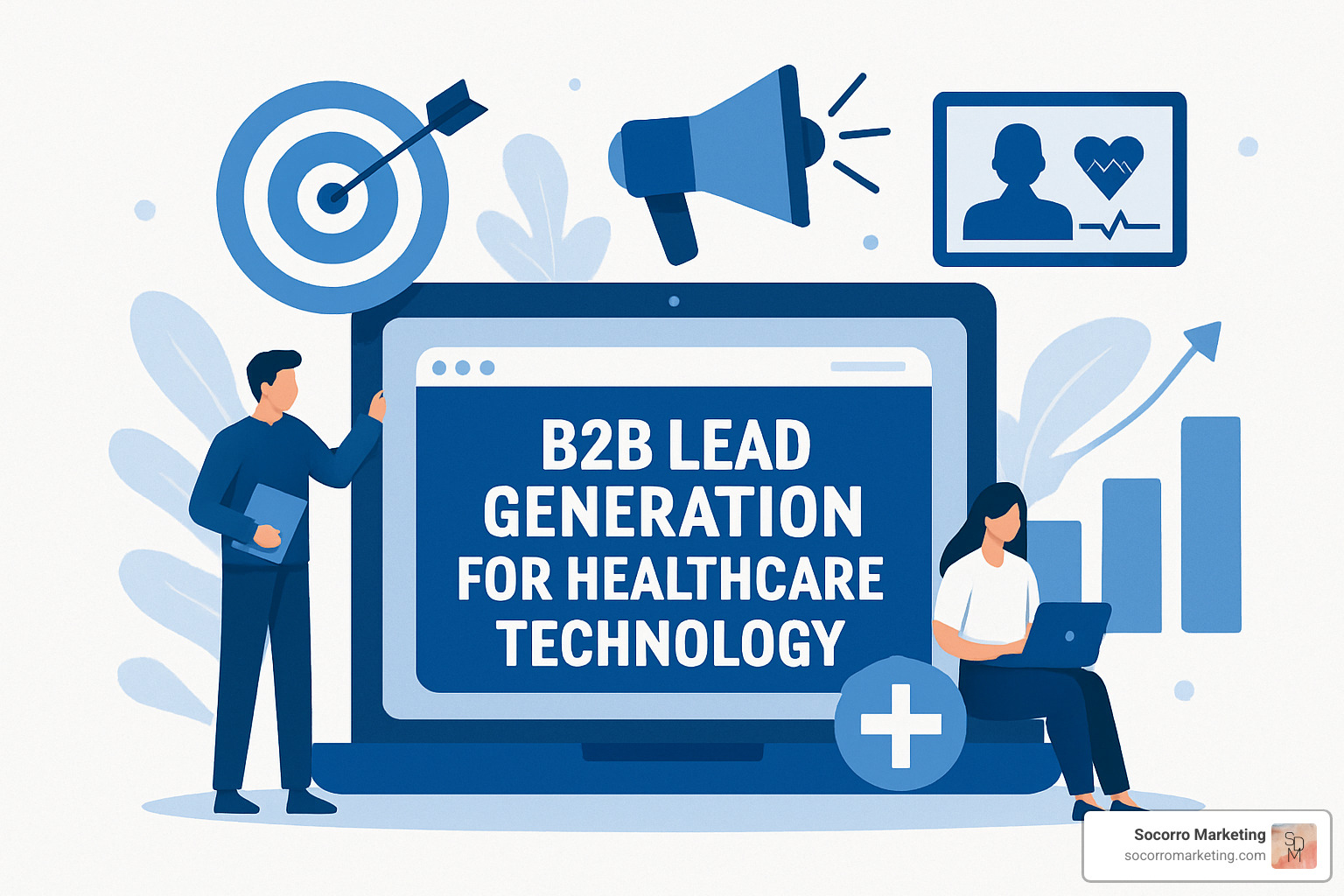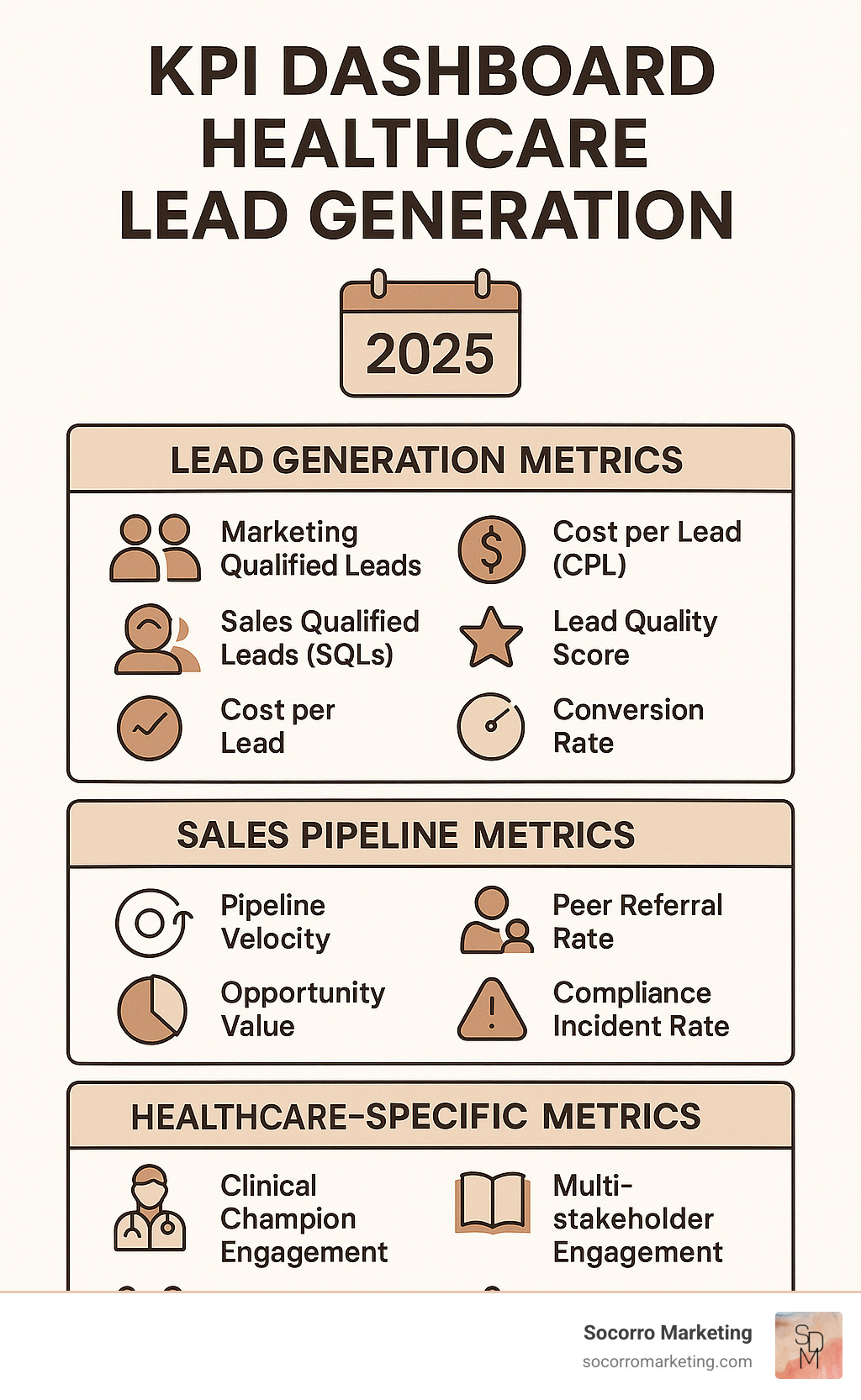B2b lead generation for healthcare technology isn’t like SaaS or manufacturing. Healthcare buyers are risk-averse, compliance-focused, and buy by committee—on average nine stakeholders per purchase.
Quick Answer: Essential Healthcare Tech Lead Generation Strategies
Healthcare tech purchases average 12 months, and 70 % of research is done before prospects talk to sales. Traditional lead-gen tactics miss the mark because they ignore these dynamics.
Risk drives everything. When patient safety is on the line, hospitals move slowly and demand proof—clinical outcomes, regulatory compliance, peer validation.
Buying committees span CMOs, CIOs, CFOs, IT directors, and clinical champions—each with different priorities and language.
I’m Grace Ascione, a registered nurse with an MBA. After 15 years helping healthcare businesses master b2b lead generation for healthcare technology, I’ve learned that clinical credibility is the fastest path to trust.

B2b lead generation for healthcare technology word roundup:
Healthcare technology companies face unique challenges that traditional B2B marketing simply can't address. After helping hundreds of healthcare tech businesses steer these waters, I've developed a framework that actually works in this complex environment.
Companies using our six-step approach have seen their cost-per-lead drop by up to 65% while improving lead quality scores by 43%. The secret isn't just good marketing - it's understanding how healthcare professionals think and make decisions.
Most healthcare tech companies think they know their ideal customer, but they're missing crucial details that make or break campaigns. Healthcare targeting goes way beyond basic demographics.
Getting Your Firmographics Right
Facility type tells you everything about how they operate - hospitals have different needs than ASCs, and long-term care facilities face completely different challenges than urgent care clinics.
Size metrics in healthcare aren't just about revenue. Number of beds, patient volume, and staff count directly impact technology needs and budget allocation. A 50-bed rural hospital has vastly different requirements than a 500-bed urban medical center.
Geographic focus matters more in healthcare than other industries. State regulations vary wildly, and rural facilities face different challenges than urban ones.
Understanding the Technology Landscape
Knowing their EHR system isn't just helpful - it's essential. Epic shops operate differently than Cerner facilities, and smaller practices using athenahealth have unique integration needs.
Interoperability standards like HL7 and FHIR aren't just technical requirements - they're strategic imperatives. Understanding where an organization stands on these standards helps you position your solution correctly.
Pain Points That Actually Drive Purchases
Administrative burden tops the list - physicians spend 50% of their time on paperwork, and they're desperate for solutions.
Patient safety concerns drive technology adoption like nothing else. When you can demonstrate how your solution reduces medication errors or improves communication, you get attention fast.
Regulatory compliance pressures are constant. HIPAA, HITECH, and state-specific requirements create ongoing challenges that smart technology can address.
| ICP Element | Healthcare-Specific Considerations |
|---|---|
| Firmographics | Facility type, bed count, ownership structure, geographic constraints |
| Technographics | EHR system, interoperability needs, cloud readiness, security requirements |
| Pain Points | Administrative burden, patient safety, compliance, financial pressures |
| Buying Process | Committee-based, risk-averse, long evaluation periods |
| Decision Makers | Clinical champions, IT directors, C-suite, procurement teams |
Healthcare professionals are naturally skeptical of marketing messages, but they're hungry for content that helps them improve patient care. Over 90% of healthcare buyers seek trusted educational content before making any purchasing decisions.
Leading with Clinical Outcomes
Healthcare buyers make decisions based on evidence, period. Your content must demonstrate measurable clinical outcomes that matter to patient care. Case studies with specific metrics - patient satisfaction scores, readmission rates, efficiency improvements - carry more weight than any sales pitch.
Peer-reviewed research gives you instant credibility. If you can partner with academic institutions or get your outcomes published in medical journals, you've hit the jackpot for healthcare content marketing.
Creating Content That Resonates
Clinical champions want medical journal-style whitepapers and continuing education opportunities. IT directors need technical implementation guides and security documentation. C-suite executives prefer industry trend reports and strategic planning resources.
Making Your Content Findable
Healthcare SEO requires understanding how medical professionals actually search for information. They use clinical terminology mixed with common terms, so your content needs to speak both languages.
Long-tail keywords perform better in healthcare than broad terms. "EHR integration for cardiology practices" will outperform "EHR software" every time.
More info about Content Marketing benefits
Webinars That Actually Generate Leads
Webinars are particularly effective for b2b lead generation for healthcare technology. The secret to successful healthcare webinars is including practicing clinicians as speakers, not just sales teams.
Generic mass marketing falls flat in healthcare. With buying committees averaging 9 decision-makers, you need account-based marketing strategies that speak to each stakeholder's specific concerns.
Strategic Account Tiering
Tier 1 accounts are your strategic targets - large health systems with high revenue potential. These deserve fully customized campaigns with dedicated resources.
Tier 2 accounts are mid-size facilities with good fit scores. They get semi-personalized campaigns with account-specific messaging.
Tier 3 accounts are smaller facilities. They receive automated campaigns with segment-level personalization.
Personalization That Actually Works
Healthcare personalization goes beyond inserting someone's name in an email. Cardiology messaging focuses on patient monitoring and cardiac event prevention. Oncology content emphasizes treatment protocol adherence. Surgery communications highlight efficiency gains and patient safety improvements.

Healthcare decision-makers are incredibly busy and bombarded with information. Research shows it takes an average of 8 touchpoints to generate a conversion in B2B healthcare sales.
The Proven Sequence
Touch 1 starts with a personalized email that references their recent news. Include a relevant case study.
Touch 2 happens three days later with a LinkedIn connection request.
Touch 3 is a brief phone call after a week. Keep it value-focused and offer specific insights.
Touch 4 delivers pure value through email - share a whitepaper with no sales pitch.
Touch 5 continues LinkedIn engagement by sharing relevant articles.
Touch 6 provides social proof through email, sharing how a similar organization achieved results.
Touch 7 is a phone call follow-up that references all previous interactions.
Touch 8 is the final email that offers to reconnect in 3-6 months.

Healthcare professionals trust their peers more than any marketing message. Research shows that 84% of B2B decision-makers begin the buying process with a referral.
The Clinical Champion Advantage
Clinical champions are practicing healthcare professionals who advocate for your solution. They're invaluable because they speak the same language as your prospects and understand real-world implementation challenges.
Case Studies That Convert
Healthcare case studies must demonstrate clinical outcomes like patient satisfaction improvements and safety improvements. But they also need to show financial impact through ROI calculations.
Implementation details matter just as much. Healthcare buyers want to understand timelines, change management strategies, and integration challenges.
Healthcare sales cycles often stretch 12+ months, making lead nurturing absolutely critical. You need automated systems that keep prospects engaged while your sales team focuses on qualified opportunities.
Healthcare-Specific Marketing Automation
Your platform must be HIPAA-compliant with proper data encryption and access controls. Segmentation strategies should account for healthcare's unique structure - segment by role, specialty, and organization type.
Lead Scoring That Works
Healthcare lead scoring must account for complex buying processes. Demographic scoring considers job title and organization size. Behavioral scoring tracks email engagement, website behavior, and content downloads.
Seamless Sales Handoff
Establish clear lead qualification criteria including minimum lead scores and engagement with key content. The handoff process should include automated notifications to sales teams and scheduled follow-up within 24 hours.

Healthcare marketing can feel like walking through a minefield. One wrong step with compliance, and you're facing serious legal consequences. But when you understand the rules and build them into your b2b lead generation for healthcare technology strategy from day one, compliance becomes your competitive advantage.
HIPAA Compliance in Lead Generation
HIPAA doesn't just govern patient health information. It impacts how you collect, store, and use any data from healthcare organizations. Even knowing which EHR system a hospital uses could be considered protected if it reveals patient care details.
Your marketing platforms must be HIPAA-compliant. Your CRM, email marketing system, and website analytics tools all need to meet HIPAA standards. That means business associate agreements, proper data encryption, and audit trails.
When collecting lead information, implement proper data encryption and access controls from the start. Prospect data should be as secure as patient data.
Email marketing in healthcare requires extra attention. You need secure, encrypted email systems and clear opt-out mechanisms. Never discuss specific patient information in marketing materials. Always maintain suppression lists and honor unsubscribe requests immediately.
GDPR and International Considerations
If you're marketing to international healthcare organizations, GDPR requires explicit consent for data processing. You need clear explanations of how you'll use their data and honor requests for data portability or deletion.
Ethical Marketing Practices
Legal compliance is just the starting point. Healthcare marketing ethics go much deeper. You're dealing with professionals whose primary concern is patient safety and outcomes.
Truth in advertising means making only claims you can substantiate with real data. Avoid exaggerated statements like "breakthrough" or "game-changing solution." Focus on proven outcomes with specific metrics.
Respect for healthcare professionals should guide every interaction. Acknowledge their expertise, respect their time constraints, and provide genuine value in every touchpoint. High-pressure sales tactics don't just fail in healthcare - they damage your reputation.
Patient-centric messaging resonates because it aligns with healthcare professionals' core values. Focus on how your technology improves patient outcomes, improves safety, or reduces medical errors.
Latest research on HIPAA compliance
Compliance and ethics aren't obstacles to overcome - they're differentiators that set you apart. When healthcare professionals see that you understand their regulatory environment and share their ethical standards, trust builds naturally.
Here's the truth about measuring b2b lead generation for healthcare technology success: traditional B2B metrics don't tell the whole story. Healthcare sales cycles stretch 12+ months, buying committees involve 9+ decision-makers, and a "lead" might nurture for months before converting. You need metrics that actually reflect how healthcare organizations buy.
After managing hundreds of healthcare marketing campaigns, I've learned that the metrics that matter most aren't always the ones that look prettiest on a dashboard. Healthcare organizations move slowly and deliberately - and your measurement approach needs to respect that reality.
The Healthcare-Specific Metrics That Actually Matter
Marketing Qualified Leads (MQLs) in healthcare look different than other industries. We're not just counting form fills - we're measuring engagement quality. A healthcare MQL might be someone who downloaded three clinical outcome studies, attended a webinar, and spent 15+ minutes on your case study pages. That's genuine interest, not just curiosity.
Sales Qualified Leads (SQLs) represent prospects your sales team has validated as having genuine need, budget, and timeline. In healthcare, this often means they've identified a clinical champion and confirmed the organization is actively evaluating solutions. Our healthcare clients see SQL conversion rates of 15-25% when targeting is done correctly.
Cost per Lead (CPL) varies dramatically by healthcare vertical. A cardiology practice lead might cost $200, while a health system CIO lead could cost $800. The key is understanding your customer lifetime value and ensuring your CPL allows for profitable growth.
Pipeline velocity - how quickly leads move through your sales process - is crucial in healthcare. We track time from first engagement to sales qualified, then from SQL to closed deal. The average healthcare technology sale takes 347 days, but top performers reduce this to 180-220 days through better nurturing.
Multi-stakeholder engagement measures how many different people within a target account you're reaching. Healthcare purchases involve committees, so engaging only one person rarely leads to success. We aim for 3-5 engaged contacts per target account.

Building Your Healthcare Analytics Dashboard
Your monthly dashboard should tell the story of your healthcare lead generation program. We track lead generation volume alongside lead quality scores because in healthcare, quality trumps quantity every time. A handful of highly engaged prospects beats hundreds of unqualified leads.
Channel performance reveals which touchpoints resonate with healthcare audiences. Email typically shows 18-22% open rates for healthcare (higher than most industries), while LinkedIn generates fewer leads but higher quality engagement. Phone calls still work remarkably well - healthcare professionals answer their phones more than most B2B buyers.
Content engagement metrics show which educational materials build trust. Clinical outcome studies typically generate 3x more downloads than product-focused content. Webinars featuring practicing clinicians see 40% higher attendance than vendor-led presentations.
Sales pipeline progression tracking helps identify bottlenecks. Many healthcare deals stall during the "committee review" phase, which can last 60-90 days. Understanding these patterns helps sales teams set proper expectations and maintain momentum.
The Power of AI in Healthcare Lead Generation
Modern b2b lead generation for healthcare technology benefits enormously from AI-powered analytics. Predictive lead scoring uses machine learning to identify which prospects are most likely to convert based on engagement patterns, not just demographics.
Intent data analysis monitors when prospects research topics related to your solution. When a hospital IT director suddenly starts downloading content about EHR integration, that's a buying signal worth acting on immediately.
Attribution modeling helps understand the complete customer journey. Healthcare buyers typically engage with 15+ pieces of content before making a purchase decision. AI helps identify which touchpoints actually influence decisions versus those that just happen to be in the path.
Continuous Optimization Strategies
The best healthcare marketing programs improve constantly. Quarterly business reviews should examine not just what happened, but why it happened. Did that webinar generate quality leads because of the topic, the speaker, or the timing?
A/B testing works differently in healthcare than other industries. Sample sizes are smaller, and results take longer to validate. We typically run tests for 60-90 days minimum and focus on testing one variable at a time.
Feedback loops between marketing and sales are crucial. Sales teams interact directly with prospects and understand their real concerns. This intelligence should flow back into campaign optimization and content creation.
Budget allocation should shift based on performance data. If LinkedIn generates higher-quality leads than email for your target audience, gradually shift budget toward LinkedIn campaigns. But make changes gradually - healthcare audiences respond poorly to dramatic shifts in messaging or approach.
More info about Digital Marketing services
The Long Game of Healthcare Metrics
Healthcare organizations make technology decisions carefully and deliberately. A prospect who downloads content today might not be ready to buy for 6-12 months. Your metrics need to account for this reality.
Track engagement over time rather than just immediate conversions. A healthcare system that consistently engages with your content for months is a better prospect than one that filled out a form once and disappeared.
Customer lifetime value in healthcare is typically much higher than other industries, which justifies longer sales cycles and higher acquisition costs. A single health system client might represent $500K+ in lifetime value, making the investment in nurturing worthwhile.
The key is patience combined with persistent measurement. Healthcare b2b lead generation for healthcare technology success comes from understanding the unique rhythms of healthcare decision-making and optimizing your approach accordingly.
Let me address the most common questions I hear from healthcare technology companies struggling with lead generation. These insights come from my 15 years helping healthcare businesses steer the unique challenges of this industry.
Here's the reality that surprises most healthcare tech companies: you need an average of 8 touchpoints before a healthcare lead converts to a sales opportunity. That's significantly higher than other B2B industries, and there's a good reason why.
Healthcare professionals are naturally risk-averse. When patient safety is on the line, they don't make quick decisions. They need time to research, validate, and build trust with potential vendors. Each touchpoint is an opportunity to demonstrate your expertise and understanding of their clinical challenges.
The magic isn't just in the number of touchpoints - it's in how you distribute them. Our omnichannel approach spreads these interactions across email, phone calls, LinkedIn engagement, and retargeting campaigns. This ensures you're reaching prospects where they're most comfortable and receptive.
What makes this different from other industries is the value requirement. Healthcare professionals won't engage with generic sales pitches. Every touchpoint must provide genuine clinical insight, peer validation, or educational content that helps them improve patient outcomes.
If you think selling to healthcare is complicated, you're absolutely right. The average healthcare buying committee now includes 9 decision-makers, and that number keeps growing as technology becomes more integrated into clinical workflows.
Here's who you're really selling to:
Clinical leadership drives the conversation around patient outcomes and workflow efficiency. The Chief Medical Officer and Chief Nursing Officer want to see how your technology improves clinical quality and reduces staff burden. Department heads and medical directors focus on specialty-specific benefits, while clinical champions influence their peers through real-world experience.
Technology and operations teams evaluate the technical feasibility. The Chief Information Officer and IT directors worry about integration, security, and system performance. Clinical informatics specialists bridge the gap between clinical needs and technical requirements, while biomedical engineering teams ensure everything works safely in the clinical environment.
Financial and administrative stakeholders control the budget and procurement process. The Chief Financial Officer wants clear ROI projections, while the CEO focuses on strategic alignment. Procurement managers negotiate contracts, and operations directors ensure implementation doesn't disrupt patient care.
Compliance and risk management teams have veto power over any technology decision. Chief Compliance Officers ensure regulatory alignment, while risk management directors evaluate potential liability. Legal counsel reviews contracts, and privacy officers ensure HIPAA compliance.
Each of these stakeholders speaks a different language and has different priorities. That's why b2b lead generation for healthcare technology requires such a nuanced approach - you're not just selling a product, you're building consensus across diverse professional perspectives.
After working with hundreds of healthcare technology companies, I've learned that traditional B2B metrics don't tell the whole story. Healthcare lead generation requires specialized KPIs that account for the industry's unique characteristics.
Volume metrics should show consistent growth, but don't expect hockey stick curves. Healthcare markets are finite and specialized. Look for steady MQL generation with 20-30% month-over-month growth and SQL conversion rates between 15-25% of MQLs. Growing pipeline value matters more than lead quantity.
Quality metrics are where healthcare lead generation really differs from other industries. Your leads should have high engagement scores (averaging 75+ points) and demonstrate multi-stakeholder engagement with 3 or more contacts per target account. Email open rates should consistently exceed 30%, which is achievable when your content provides genuine clinical value.
Efficiency metrics reveal program optimization opportunities. Your cost-per-lead should decrease over time as you refine targeting and messaging. Conversion rates should improve across all funnel stages, and time-to-qualification should shorten as your lead scoring becomes more predictive.
Revenue impact is the ultimate measure of success. Look for increasing average deal sizes as you target better-fit prospects, shorter sales cycles (targeting 10-12 months instead of 18+), and higher win rates of 25-35% for qualified opportunities.
The key insight I share with clients is this: healthcare lead generation is a marathon, not a sprint. Your metrics should reflect steady, sustainable growth that builds long-term relationships with healthcare professionals who become advocates for your solution.
The healthcare technology landscape is evolving rapidly, and b2b lead generation for healthcare technology has never been more critical - or more challenging. The six-step framework we've walked through together isn't just another marketing playbook. It's a roadmap built from real-world experience working with healthcare professionals who understand both the clinical side and the business realities.
What makes healthcare different from every other industry? It's the weight of responsibility that comes with every decision. When you're selling to healthcare organizations, you're not just selling to buyers - you're selling to people who hold patient lives in their hands. That changes everything about how they evaluate, research, and ultimately purchase technology solutions.
The nurse-managed marketing approach we use at Socorro Marketing gives us a unique window into this world. Having spent years in clinical settings, I understand the skepticism healthcare professionals feel when vendors make grand promises. I know why they need to see peer validation, clinical outcomes data, and extensive proof before they'll even consider a new technology.
This clinical insight shapes every recommendation in our framework. When we talk about building trust through thought leadership, it's because I've seen how healthcare professionals consume information - they want education, not sales pitches. When we emphasize peer influence and social proof, it's because I understand how much weight healthcare professionals place on what their colleagues say.
The healthcare technology market is experiencing unprecedented growth. The U.S. HealthTech market is projected to grow more than 15% per year through 2027. But this growth brings increased competition and more sophisticated buyers. The healthcare organizations that thrive will be those that can cut through the noise with authentic, value-driven marketing that speaks directly to clinical and operational needs.
Your success in b2b lead generation for healthcare technology won't come from generic B2B tactics or flashy campaigns. It will come from understanding the unique dynamics of healthcare decision-making, respecting the complexity of the buying process, and consistently delivering value that helps healthcare professionals improve patient outcomes.
The framework we've outlined - from defining your ideal customer profile to automating lead nurturing - works because it's built on this foundation of clinical understanding. Each step addresses the specific challenges and concerns that healthcare buyers face, from regulatory compliance to risk mitigation to clinical validation.
Ready to transform your healthcare technology lead generation with strategies that actually understand your market? Contact us for a custom lead-gen blueprint that combines our clinical expertise with proven marketing strategies. We'll help you steer the complex healthcare landscape and generate the qualified leads your business needs to grow.